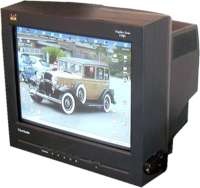History of display technology
This article needs additional citations for verification. (June 2009) |
Over the years, a variety of display devices and technologies have been used in order to display electronic data in a way that is legible to humans.
Early history
One of the earliest electronic displays is the cathode ray tube (CRT), which was made commercial in 1922. The CRT consists of an electron gun that forms images by firing electrons onto a phosphor-coated screen. The earliest CRTs were monochrome and were used primarily in oscilloscopes and black and white televisions. The first commercial colour CRT was produced in 1954.[1] CRTs were the single most popular display technology used in television sets and computer monitors for over half a century; it was not until the 2000s that LCDs began to gradually replace them.
A derivative of CRTs were storage tubes, which had the ability to retain information displayed on them, unlike standard CRTs which need to be refreshed periodically. In 1968, Tektronix introduced the Direct-View Bistable Storage Tube, which went on to be widely used in oscilloscopes and computer terminals.[2]
Cathode ray tube
Monochrome CRT
1922 Monochrome cathode ray tube:

Color CRT
Color cathode ray tube for the display of color television[3]:

Direct-View Bistable Storage Tube
1968[4] The Direct-View Bistable Storage Tube CRT retains static information displayed upon it, written using a steerable electron beam that can be turned off. In principle the DVBST is similar to an Etch-a-Sketch, and was used in vector displays of early computers and in oscilloscopes.

Flip-flap/disc display
1957 Split-flap display:
1961 Flip-disc display:

Monochrome plasma display
1964 Monochrome plasma display:

Light-emitting diode
1968 Light-emitting diode:


Eggcrate display
1968 Eggcrate display
Vacuum fluorescent display
1967 Vacuum fluorescent display as used in consumer electronics.


Twisted nematic field effect LCD
1972 Twisted nematic field effect LCD[5][6]:

Super-twisted nematic LCD
1984 Super-twisted nematic display (STN LCD) to improve passive-matrix LCDs, allowing for the first time higher resolution panels with 540x270 pixels.

Pin screen

1969 Braille display:[7]
Thin film transistor LCD
1986 Color Thin film transistor liquid crystal display[8]:

Full-color plasma display
1995 Full-color plasma display[9]:
Organic light-emitting diode
2003 Organic light-emitting diode display (OLED)
[10]

2003 Active-matrix OLED (AMOLED):[11]
Electronic paper
2004 Electronic paper[12]:


Electroluminescent display
1974 Electroluminescent display (ELD)[13]:
Stroboscopic display
196x Stroboscopic display[14][15]
See also
References
- ^ - earlytelevision.org - Picture Tubes, 15GP22 Color CRT
- ^ medical-answers.org - Tektronix 4014
- ^ - earlytelevision.org - Picture Tubes, 15GP22 Color CRT
- ^ medical-answers.org - Tektronix 4014
- ^ Joseph Castellano, "Modifying Light', American Scientist, September-October 2006
- ^ displayblog.com - George Heilmeier: LCD Inventor
- ^ U.S. patent 3,594,787;
- ^ auburn.edu - Note on the Liquid Crystal Display Industry
- ^ indoclient.com - Television Development
- ^ rpi.edu - Lighting industry, Structure and technology in the transition to solid state
- ^ WP-de Organische Leuchtdiode 2011-05-17
- ^ hitech-projects.com - E-paper production flow - Adapting production workflow processes for digital newsprint
- ^ faqs.org - Patent application title: Personal article with electron luminescent display
- ^ Stroboscopic display on the Soviet calculator "RASA" (video)
- ^ Soviet made "RASA" electronic calculator with stroboscopic display


